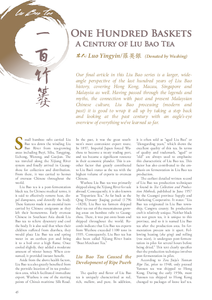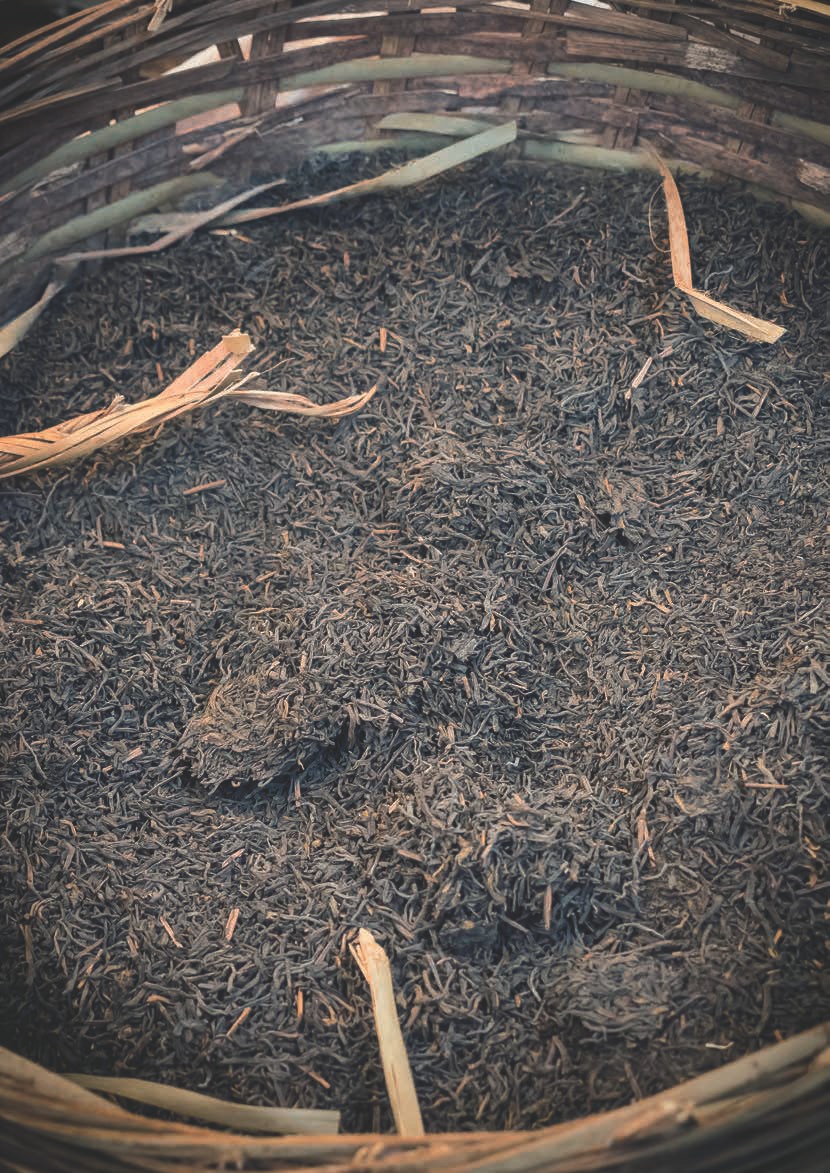
 |
|
Small bamboo rafts carried Liu Bao tea down the winding Liu Bao River from tea-growing areas including Buyi, Siliu, Tangping, Lichong, Wutong, and Gaojian. The tea traveled along the Xijiang River system and finally arrived in Guangzhou for collection and distribution. From there, it was carried to homes of overseas Chinese throughout the world.
Liu Bao tea is a post-fermentation black tea. In Chinese medical terms, it is said to effectively remove heat, dispel dampness, and detoxify the body. These features made it an essential item carried by Chinese emigrants as they left their hometowns. Early overseas Chinese in Southeast Asia drank Liu Bao tea to relieve dysentery and cool the body. It is also said that when their children suffered from diarrhea, they would place Liu Bao tea and spring water in an earthen pot and bring it to a boil over a high flame. Once cooled slightly, they added a moderate amount of winter honey. When consumed, it provided instant benefit.
Aside from the above health factors, Liu Bao tea also greatly benefited from the portside location of its tea production area, which facilitated immediate export. Wuzhou is one of the starting points of China's maritime Silk Road. In the past, it was the great southwest's most convenient export route. In 1897, Imperial Japan forced Wuzhou to become a treaty trading port, and tea became a significant resource in their economic plunder. This is another factor that greatly contributed to Liu Bao's status as the tea with the highest volume of exports to overseas Chinese.
Wuzhou Liu Bao tea was primarily shipped along the Xijiang River for sale abroad. Consequently, it is also known as "Expatriate Tea." As far back as the Qing Dynasty Jiaqing period (1796 - 1820), Liu Bao tea farmers shipped their tea out of the mountainous growing areas on bamboo rafts to Guangzhou. There, it was put onto boats and shipped throughout the world. Records indicate that Liu Bao tea exports from Wuzhou exceeded 1100 tons in 1935. Consequently, Liu Bao tea has also been called Xijiang River basin "Boat Merchant Tea."
The quality and flavor of Liu Bao tea is uniquely characterized as red, rich, mellow, and pure. In addition, it is often sold as "aged Liu Bao" or "disregarding years," which shows the excellent quality of this tea. In terms of quality and trademark, "aged" or "old" are always used to emphasize this characteristic of Liu Bao tea. This factor has also contributed to the emphasis on fermentation in Liu Bao tea production.
The earliest detailed written record of Liu Bao tea production techniques is found in Tea Collection and Production Methods, published in June 1957 by the Guangxi province Supply and Marketing Cooperative. It states: "Liu Bao tea originated in Liu Bao township, Cangwu county. Its production craft is relatively unique. Neither black tea nor green tea, it is unique to this province, and so it is named Liu Bao tea after the production area. Its fermentation process sets it apart. Following heating (sha qing) and rolling (rou nian), it undergoes post-fermentation in piles for several hours before being dried." This text clearly specifies that the production technique involves post-fermentation in piles.
According to Zou Jiaju's Yunnan Ripe Tea, prior to 1948, only pressed Yunnan tea was shipped to Hong Kong. During the early 1950s, most Yunnan tea shipped to Hong Kong changed to packages of loose leaf tea. That period happens to coincide with the communist revolution, when the popularity of loose leaf Liu Bao tea packed in bamboo baskets peaked in Guangdong, Hong Kong, Macau, and Southeast Asia. Hong Kong tea sellers were inspired by the mellow fragrance of Liu Bao that resulted from pile storage. Based on market demand, they began to experiment with processing methods using humid environments such as cellars and warehouses to accelerate the post-fermentation of Liu Bao and puerh tea. The market continued to change, and, by the late 1950s, this type of "flood tea" gradually came to dominate Hong Kong tea houses. Consumers widely appreciated the mellow fragrance, red liquor, and brown base of this ripe tea.
Due to the above factors, the Native Produce & Animal Byproducts Import & Export Company (CNNP), Yunnan Branch initiated experimentation into post-fermentation of tea for export. It is said that Wuzhou tea factories still employ staff who were sent from Yunnan to learn post-fermentation techniques for ripe puerh production. As the culmination of this study and investigation, CNNP Yunnan successfully produced ripe puerh tea in 1973.

Liu Bao tea is primarily produced for export to overseas Chinese. It seems likely that Liu Bao production techniques were gradually perfected over a long time based on the requirements of Cantonese or Hong Kong tea merchants.
The "corner pile fermentation" performed following firing and rolling is also known as "wet pile fermentation." This procedure is crucial to the unique quality of Liu Bao tea. Its goal is to hasten the transformation of the tea's internal substances through the warmth and humidity of the wet pile process, thereby reducing bitterness and causing the flavor to become pure and mild.
The unique character of Liu Bao tea is then catalyzed through the careful "cold fermentation" procedure (as opposed to the thermal fermentation earlier on). The processed tea material is first dried over a pine fire. Moisture is then added to the tea until it reaches a suitable level of wetness. It is then pile-fermented for seven to ten days to supplement deficiencies in the initial fermentation. In traditional production techniques, however, steamed tea was stored in piles for 20 to 30 days. The primary function of the wet fermentation is to accelerate changes to internal substances in the tea, thereby causing materials such as theaflavins and thearubigins to increase. The color and fragrance of the tea increases, which gives Liu Bao tea its characteristic style.
The Liu Bao tea produced in Wuzhou is distinguished by another important feature - namely, its aging process is unlike that of other teas. After fermentation, Liu Bao tea is generally stored in air raid shelters to age. The temperature, humidity, and microorganisms are extremely beneficial in aging the tea. The tea is stored in this environment for two to three years before being sold. This relatively long aging process is another characteristic of Liu Bao tea, which distinguishes it from the brief aging process of other types of Black Tea.
Another unique aspect of the aging process contributes to the special mellow purity of Liu Bao tea. This is due to the fact that early Liu Bao tea was transported by water, which further helped to shape the character of the tea. The tea was shipped along the Liu Bao River on bamboo rafts, which unintentionally helped contribute to its unique quality. The damp environment on the river with water constantly splashing onto the bamboo baskets, combined with the hot sun, caused the tea to continuously ferment and age. This shipping process further contributed to the mellow fragrance of the tea.

Today, it is still not clearly known when Liu Bao began to grow and produce tea. However, historical records indicate that Liu Bao tea was listed among the 24 great teas during the Qing dynasty Jiaqing period (1796 - 1820).
Before World War II, Liu Bao tea was praised by Chinese in Hong Kong, Macau, and Southeast Asia and experienced brisk sales. Other factors contributed to the rapid development in Liu Bao tea, including low shipping costs and stable governments in major buying areas including Hong Kong, Macau, Singapore, and Malaysia. In addition to Liu Bao, large growing areas sprang up in neighboring regions and production volumes increased.
At the height of Liu Bao tea, tea farmers brought their initially processed tea to Hekou Street. During the tea harvest, this street was filled with the sound of trading. To this day Liu Bao town still contains a tea collection place, which provides a glimpse of the spectacle of those days. According to local elders, many tea companies were established in those years. Large tea companies from all over set up branches in Liu Bao. These included famous tea companies such as Yingji, Wanshen, Guangyuantai, Xieji, Tianshunxiang and Shenchang.
Major Hong Kong tea companies successively moved into Liu Bao and began buying tea. Of these, Guangyuantai is the most famous. At the time, the same trademarks were printed on the bamboo baskets used to ship the tea and on the pillars outside the buildings of the large tea companies.
Liu Bao tea's long period of prosperity came to an end in 1937 when Japan invaded China, and Guangzhou fell into enemy hands. During the ten years of great decline between 1937 and 1949, many of the tea companies stopped production or went bankrupt. A resurgence in the production of Liu Bao tea occurred after the revolution in 1951. Land reform returned land to farmers, and tea production was greatly expanded. In addition, the highway between Liu Bao and Guangdong opened in 1957, which also helped accelerate growth of Liu Bao tea.
This period of prosperity during the 1950s did not last long. In 1958, communes were formed and the Three Red Banners (General Line for Socialist Construction, Great Leap Forward, and People's Communes) were initiated. The Liu Bao tea industry, having just emerged from the darkness, was once again pushed into a period of uncertainty. The Great Leap Forward was carried out on a grand scale for approximately three years. It gradually came to an end in late 1960, but Liu Bao tea production was greatly reduced.
Another significant factor contributed to the decline of Liu Bao tea. At the time, purchase prices for Liu Bao tea were low - often lower than those of green tea of the same grade. Green tea processing is easier than that of Liu Bao tea, however, causing tea farmers to switch to green tea production. This severely damaged the traditional post-fermentation craft of Liu Bao tea. An even more significant factor, however, came from the communal or collective tea farms and factories. Tea farmers no longer approached their work with the dynamism of the past. Tea plantation management, production, and quality gradually fell. Local elders recount with sadness that the traditional "age" and "red" of Liu Bao tea had changed. Traditional techniques were lost, and Liu Bao tea gradually disappeared from the Hong Kong and Macau markets.
